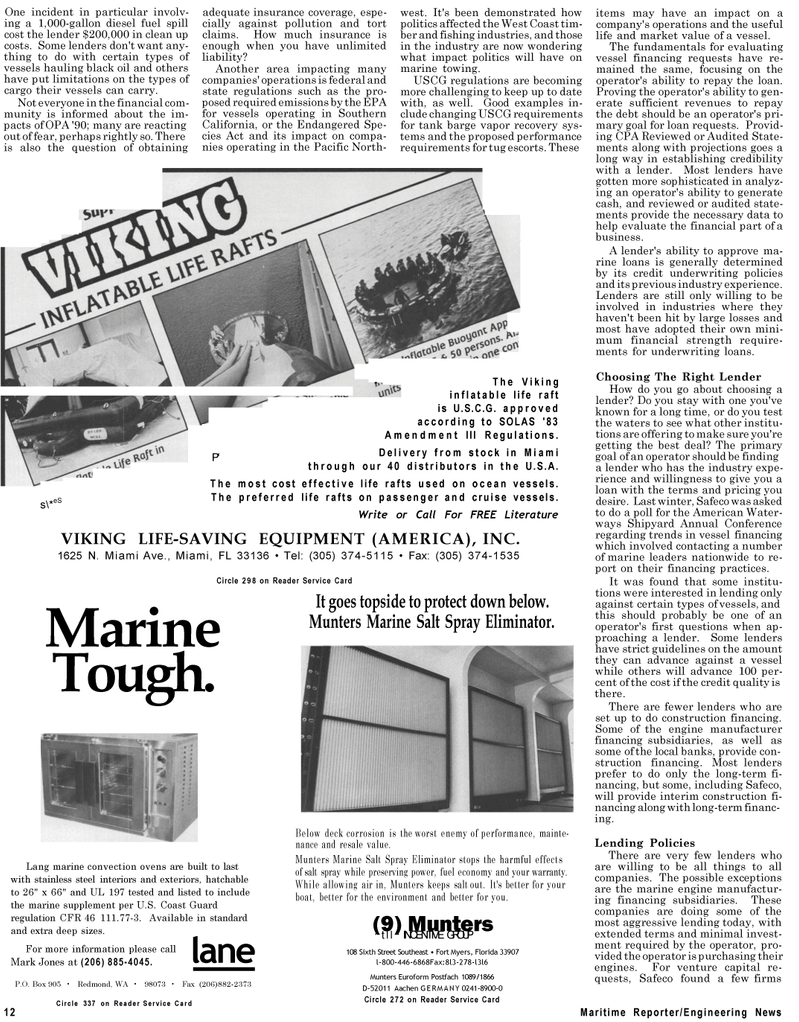
Page 10: of Maritime Reporter Magazine (September 1994)
Read this page in Pdf, Flash or Html5 edition of September 1994 Maritime Reporter Magazine
One incident in particular involv- ing a 1,000-gallon diesel fuel spill cost the lender $200,000 in clean up costs. Some lenders don't want any- thing to do with certain types of vessels hauling black oil and others have put limitations on the types of cargo their vessels can carry.
Not everyone in the financial com- munity is informed about the im- pacts of OPA '90; many are reacting out of fear, perhaps rightly so. There is also the question of obtaining adequate insurance coverage, espe- cially against pollution and tort claims. How much insurance is enough when you have unlimited liability?
Another area impacting many companies' operations is federal and state regulations such as the pro- posed required emissions by the EPA for vessels operating in Southern
California, or the Endangered Spe- cies Act and its impact on compa- nies operating in the Pacific North- west. It's been demonstrated how politics affected the West Coast tim- ber and fishing industries, and those in the industry are now wondering what impact politics will have on marine towing.
USCG regulations are becoming more challenging to keep up to date with, as well. Good examples in- clude changing USCG requirements for tank barge vapor recovery sys- tems and the proposed performance requirements for tug escorts. These - The Viking s\*eS inflatable life raft is U.S.C.G. approved according to SOLAS '83
Amendment III Regulations.
Delivery from stock in Miami through our 40 distributors in the U.S.A.
The most cost effective life rafts used on ocean vessels.
The preferred life rafts on passenger and cruise vessels.
Write or Call For FREE Literature
P'
VIKING LIFE-SAVING EQUIPMENT (AMERICA), INC. 1625 N. Miami Ave., Miami, FL 33136 • Tel: (305) 374-5115 • Fax: (305) 374-1535
Circle 298 on Reader Service Card
Marine Tough.
Lang marine convection ovens are built to last with stainless steel interiors and exteriors, hatchable to 26" x 66" and UL 197 tested and listed to include the marine supplement per U.S. Coast Guard regulation CFR 46 111.77-3. Available in standard and extra deep sizes.
For more information please call
Mark Jones at (206) 885-4045. lane
P.O. Box 905 • Redmond, WA • 98073 • Fax (206)882-2373
It goes topside to protect down below.
Munters Marine Salt Spray Eliminator. 12
Circle 337 on Reader Service Card
Below deck corrosion is the worst enemy of performance, mainte- nance and resale value.
Munters Marine Salt Spray Eliminator stops the harmful effects of salt spray while preserving power, fuel economy and your warranty.
While allowing air in, Munters keeps salt out. It's better for your boat, better for the environment and better for you. (9) Munters ^tll^ INCENTIVE GROUP 108 Sixth Street Southeast • Fort Myers, Florida 33907 l-800-446-6868Fax:8l3-278-l3l6
Munters Euroform Postfach 1089/1866
D-52011 Aachen GERMANY 0241-8900-0
Circle 272 on Reader Service Card items may have an impact on a company's operations and the useful life and market value of a vessel.
The fundamentals for evaluating vessel financing requests have re- mained the same, focusing on the operator's ability to repay the loan.
Proving the operator's ability to gen- erate sufficient revenues to repay the debt should be an operator's pri- mary goal for loan requests. Provid- ing CPA Reviewed or Audited State- ments along with projections goes a long way in establishing credibility with a lender. Most lenders have gotten more sophisticated in analyz- ing an operator's ability to generate cash, and reviewed or audited state- ments provide the necessary data to help evaluate the financial part of a business.
A lender's ability to approve ma- rine loans is generally determined by its credit underwriting policies and its previous industry experience.
Lenders are still only willing to be involved in industries where they haven't been hit by large losses and most have adopted their own mini- mum financial strength require- ments for underwriting loans.
Choosing The Right Lender
How do you go about choosing a lender? Do you stay with one you've known for a long time, or do you test the waters to see what other institu- tions are offering to make sure you're getting the best deal? The primary goal of an operator should be finding a lender who has the industry expe- rience and willingness to give you a loan with the terms and pricing you desire. Last winter, Safeco was asked to do a poll for the American Water- ways Shipyard Annual Conference regarding trends in vessel financing which involved contacting a number of marine leaders nationwide to re- port on their financing practices.
It was found that some institu- tions were interested in lending only against certain types of vessels, and this should probably be one of an operator's first questions when ap- proaching a lender. Some lenders have strict guidelines on the amount they can advance against a vessel while others will advance 100 per- cent of the cost if the credit quality is there.
There are fewer lenders who are set up to do construction financing.
Some of the engine manufacturer financing subsidiaries, as well as some of the local banks, provide con- struction financing. Most lenders prefer to do only the long-term fi- nancing, but some, including Safeco, will provide interim construction fi- nancing along with long-term financ- ing.
Lending Policies
There are very few lenders who are willing to be all things to all companies. The possible exceptions are the marine engine manufactur- ing financing subsidiaries. These companies are doing some of the most aggressive lending today, with extended terms and minimal invest- ment required by the operator, pro- vided the operator is purchasing their engines. For venture capital re- quests, Safeco found a few firms
Maritime Reporter/Engineering News

 9
9

 11
11
